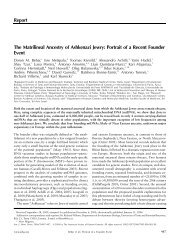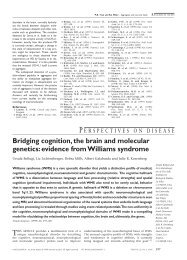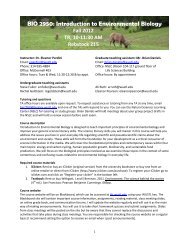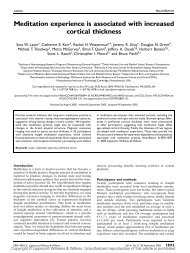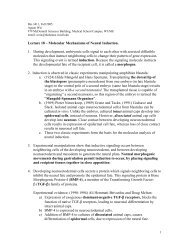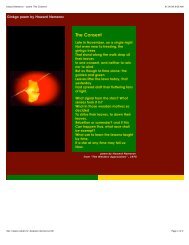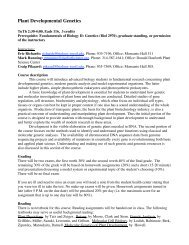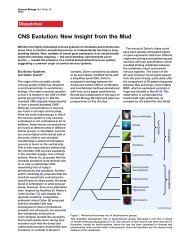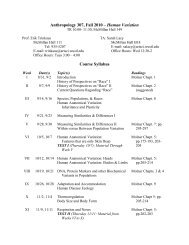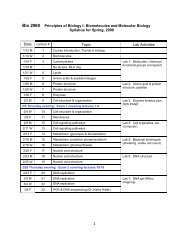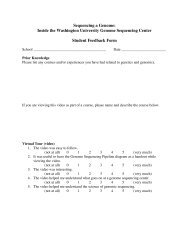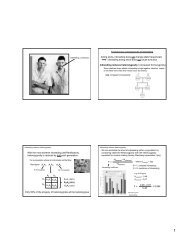Expression Cloning of noggin, a New Dorsalizing Factor Localized ...
Expression Cloning of noggin, a New Dorsalizing Factor Localized ...
Expression Cloning of noggin, a New Dorsalizing Factor Localized ...
You also want an ePaper? Increase the reach of your titles
YUMPU automatically turns print PDFs into web optimized ePapers that Google loves.
Cell<br />
634<br />
4<br />
4<br />
LacZ<br />
F<br />
+ <strong>noggin</strong><br />
obtained with embryos that were tilted 90° immediately<br />
following fertilization and then marked with a vital dye on<br />
their uppermost side to indicate the future dorsal side<br />
(Peng, 1991). Older (32-cell stage) blastula embryos were<br />
also dissected into dorsal-ventral and animal-vegetal<br />
halves. No enrichment <strong>of</strong> <strong>noggin</strong> mRNA in any <strong>of</strong> the hemispheres<br />
was seen relative to the total embryo (data not<br />
shown). In addition, UV treatment did not alter the abundance<br />
<strong>of</strong> maternally deposited <strong>noggin</strong> RNA, indicating no<br />
preferential degradation in ventral tissues (Figure 8). Samples<br />
with known amounts <strong>of</strong> in vitro synthesized <strong>noggin</strong><br />
mRNA were included in the RNAase protection assay (Figure<br />
8). From these and other data we estimate that there<br />
is approximately0.1 pg <strong>of</strong> <strong>noggin</strong> mRNA per blastula stage<br />
embryo and 1 pg per gastrula stage embryo.<br />
Figure 5. Dorsal Rescue <strong>of</strong> 32-Cell Embryos with <strong>noggin</strong> RNA<br />
Ventralized 32-cell stage embryos were coinjected with 25 pg <strong>of</strong> <strong>noggin</strong><br />
and 0.5 ng <strong>of</strong> 6-galactosidase RNAs into a single blastomere in either<br />
the animal (tier l), marginal (tiers 2 and 3) or vegetal (tier 4) regions.<br />
Embryos were grown to about stage 25 and scored for dorsal axis<br />
rescue.<br />
halves, as well as animal and vegetal halves. <strong>noggin</strong> transcripts<br />
were found to be distributed evenly between dorsal<br />
and ventral hemispheres as well as animal and vegetal<br />
hemispheres (Figure 8). The same result (not shown) was<br />
In Situ Hybridization; Zygotic <strong>Expression</strong> <strong>of</strong> <strong>noggin</strong><br />
in the Spemann Organizer<br />
The localization <strong>of</strong> <strong>noggin</strong> transcripts in developing embryos<br />
was examined in greater detail using whole-mount<br />
in situ hybridization (Harland, 1991). Whole fixed embryos<br />
were hybridized with digoxigenin-containing RNA probes.<br />
Hybridized RNA probe was then visualized with an alkaline<br />
phosphatase-conjugated anti-digoxigenin antibody. The<br />
specificity <strong>of</strong> hybridization seen with antisense <strong>noggin</strong><br />
probes was tested both by hybridizing embryos with sense<br />
Figure 6. Lineage Tracing <strong>of</strong> <strong>noggin</strong>-Injected Blastomeres<br />
Ventralized embryos (32~cell stage) were coinjected with 25 pg <strong>of</strong> <strong>noggin</strong> and 0.5 ng <strong>of</strong> 5-galactosidase RNAs. The embryos were then stained with<br />
X-gal at about stage 25. Diffuse background staining can be seen in the endoderm. Specific staining from injected f3-galactosidase RNA can be<br />
seen as darker and more discrete points <strong>of</strong> staining. Arrows indicate cement glands. Arrowheads indicate staining <strong>of</strong> lineage tracer.



